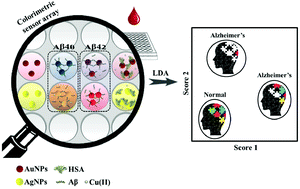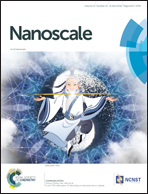Label-free detection of β-amyloid peptides (Aβ40 and Aβ42): a colorimetric sensor array for plasma monitoring of Alzheimer's disease†
Abstract
Monitoring the ratio of 40- and 42-residue amyloid β peptides (i.e., Aβ40 and Aβ42) in human plasma is considered one of the hallmarks of detection of the early stage of Alzheimer's disease (AD). Therefore, development of a specific, yet non-antibody-based method for simultaneous detection of Aβ40 and Aβ42 may have considerable clinical applications. Here, we developed a ‘nanoparticle-based colorimetric sensor array’ utilizing label-free gold and silver nanoparticles for visual detection of Aβ42 and Aβ40. Different aggregation behaviors of nanoparticles through their conjugation with Aβ42 and Aβ40 followed by the coordination of Aβ42 and Aβ40 with Cu(II) led to diverse spectral and color changes. The spectral changes were quantitatively differentiated by a supervised pattern recognition approach, linear discriminant analysis (LDA). The proposed sensor array was able to discriminate among Aβ42, Aβ40, and HSA in different concentrations (50 nmol L−1 to 500 nmol L−1) and their mixtures. Moreover, the sensor array had the capability to identify structurally similar Aβ peptides in human plasma samples. The developed sensor array technology might pave the way for a cheap and rapid, yet robust, platform for high-throughput screening of human plasma for defining the at-risk population for AD.



 Please wait while we load your content...
Please wait while we load your content...